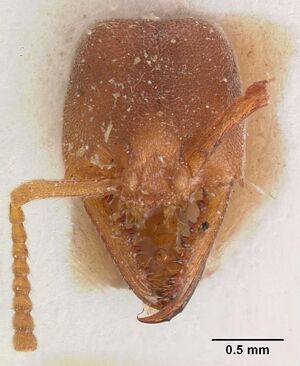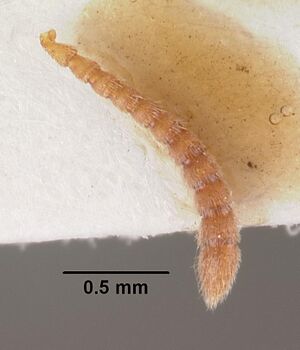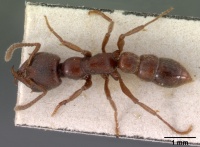Stigmatomma impressifrons
| Stigmatomma impressifrons | |
|---|---|

| |
| Scientific classification | |
| Kingdom: | Animalia |
| Phylum: | Arthropoda |
| Class: | Insecta |
| Order: | Hymenoptera |
| Family: | Formicidae |
| Subfamily: | Amblyoponinae |
| Tribe: | Amblyoponini |
| Genus: | Stigmatomma |
| Species: | S. impressifrons |
| Binomial name | |
| Stigmatomma impressifrons Emery, 1869 | |
Little is known about the biology of this species. One collection (Lamto, Ivory Coast, ANTC5372, Lévieux, 1968) is from "plain savanna."
Identification
Distribution
Latitudinal Distribution Pattern
Latitudinal Range: 43.066667° to 36.59833333°.
| North Temperate |
North Subtropical |
Tropical | South Subtropical |
South Temperate |
- Source: AntMaps
Distribution based on Regional Taxon Lists
Palaearctic Region: Bulgaria, Greece, Iberian Peninsula, Italy (type locality), Spain.
Distribution based on AntMaps
Distribution based on AntWeb specimens
Check data from AntWeb
Countries Occupied
| Number of countries occupied by this species based on AntWiki Regional Taxon Lists. In general, fewer countries occupied indicates a narrower range, while more countries indicates a more widespread species. |

|
Estimated Abundance
| Relative abundance based on number of AntMaps records per species (this species within the purple bar). Fewer records (to the left) indicates a less abundant/encountered species while more records (to the right) indicates more abundant/encountered species. |

|
Biology
Castes
Worker
Images from AntWeb
   
| |
| Worker. Specimen code casent0172239. Photographer April Nobile, uploaded by California Academy of Sciences. | Owned by ANIC, Canberra, Australia. |
    
| |
| Worker. Specimen code casent0102515. Photographer April Nobile, uploaded by California Academy of Sciences. | Owned by MHNG, Geneva, Switzerland. |
Nomenclature
The following information is derived from Barry Bolton's Online Catalogue of the Ants of the World.
- impressifrons. Stigmatomma impressifrons Emery, 1869b: 13, pl. 1, fig. 8 (w.q.) ITALY.
- Type-material: syntype workers, syntype queens (numbers not stated).
- Type-locality: Italy: vic. Naples, woods of Capodimonte (C. Emery).
- Type-depositories: MHNG, MSNG.
- Emery, 1915a: 254 (m.).
- Combination in Amblyopone: Emery & Forel, 1879: 455;
- combination in Stigmatomma: Emery, in Dalla Torre, 1893: 14; Emery, 1909c: 357; Yoshimura & Fisher, 2012a: 19.
- Status as species: Emery, 1875a: 74; Emery, 1875b: 472; Emery, 1878b: 50; Emery & Forel, 1879: 455; André, 1882c: 234 (in key); Forel, 1886e: clxvii; Dalla Torre, 1893: 14; Emery, 1895b: 59; Emery, 1909c: 357; Emery, 1911d: 24; Santschi, 1915a: 55 (in key); Emery, 1915a: 254; Emery, 1916b: 101 (in key); Bondroit, 1918: 80; Müller, 1923b: 24 (in key); Kutter, 1927: 98; Grandi, 1935: 98; Brown, 1960a: 168; Baroni Urbani, 1971c: 10; Baroni Urbani, 1978a: 44 (redescription); Agosti & Collingwood, 1987a: 53; Agosti & Collingwood, 1987b: 264 (in key); Tinaut, 1990d: 192; Mei, 1992a: 412; Atanassov & Dlussky, 1992: 62; Bolton, 1995b: 62; Poldi, et al. 1995: 2; Petrov, 2006: 83 (in key); Lapeva-Gjonova, et al. 2010: 5; Legakis, 2011: 3; Borowiec, L. & Salata, 2012: 536; Borowiec, L. 2014: 162; Lebas, et al. 2016: 106; Salata & Borowiec, 2018c: 48.
- Distribution: Bulgaria, Greece, Italy (+ Sicily), Spain.
Unless otherwise noted the text for the remainder of this section is reported from the publication that includes the original description.
Description
Worker
Borowiec and Salata (2022) - (partly after Baroni-Urbani 1978). Small to large: HL: 1.21; HW: 1.29; SL: 0.79. Color. Whole body from rusty yellow to greyish brown, antennae and legs yellow . Head. As long as or slightly wider than long, widest in anterior third then softly converging posterad, occipital corners rounded, occipital margin shallowly concave. Clypeus very short, transverse, with softly rounded anterior margin armed with a row of slightly angulated denticles, each denticle at apex with a minute spine. Clypeus with diffused longitudinal striation, surface microreticulate but shiny, with a pair of long erected setae in the middle and few short erected setae laterally. Mandibles long and narrow, with striated sculpture, inner margin with 5 large, bidentate apically teeth, two or three large unidentate teeth behind last bidentate tooth and small tooth close to apex. Anterolateral corners of head often prolongate in denticle or spine. Head with very distinct granulate sculpture, frons sometimes with distinct longitudinal striation, interspaces appear irregular and slightly dull, with moderately long and moderately dense subdecumbent pubescence, erected setae absent, ventral side of head mostly with short subdecumbent pubescence and few erected setae. Scape very short, 0.6 times as long as width of head, stout, slightly widened from base to apex, but apically slightly constricted, its surface distinctly microreticulate and slightly dull, with short subdecumbent to suberect pubescence, ventral surface also with few erect setae. Funicular segments transverse, stout, only first segment 1.4 times as long as wide, segments 2 longer than wide, segments 3-6 short, slightly wider than long, the rest of funicular segments distinctly broader than six basal segments. Eyes minute but well visible, composed with more than four ommatidia. Mesosoma. Elongate, 2.4 times as long as wide, dorsally and laterally with fine microreticulation with sparse punctuation, propodeum on sides with oblique and longitudinal striation, interspaces shiny, with short and sparse appressed to decumbent pubescence , surface from slightly shiny to slightly granulate. In lateral view pronotum slightly convex, mesonotum and propodeum straight, posterior face of propodeum oblique, mesonotal suture distinct. Mesosomal dorsum lacking erected setae. Waist and gaster. Petiole in form of cubicous node broadly connected with gaster, surface sparsely punctate, interspaces slightly irregular but shiny, covered with sparse and short pubbescence in anterior half and longer subdecumbent to decumbent, longer pubescence basally. Gaster longer than mesosoma, tergites with micropunctation and fine microreticulation, surface shiny, covered with moderately long and moderately dense subdecumbent pubescence not covering surface and few to several longer standing hairs. Legs. Stout, tibiae distinctly widened from base to apex, surface covered with moderately long and sparse subdecumbent to decumbent hairs, erected setae absent sometimes few additional suberect hairs present.
References
- Atanassov, N.; Dlussky, G. M. 1992. Fauna of Bulgaria. Hymenoptera, Formicidae. Fauna Bûlg. 22: 1-310 (page 62, see also)
- Baroni Urbani, C. 1978a. Contributo alla conoscenza del genere Amblyopone Erichson (Hymenoptera: Formicidae). Mitt. Schweiz. Entomol. Ges. 51: 39-51 (page 44, see also)
- Bolton, B. 1995b. A new general catalogue of the ants of the world. Cambridge, Mass.: Harvard University Press, 504 pp. (page 62, catalogue)
- Borowiec, L. 2014. Catalogue of ants of Europe, the Mediterranean Basin and adjacent regions (Hymenoptera: Formicidae). Genus (Wroclaw) 25(1-2): 1-340.
- Borowiec, L., Salata, S. 2022. A monographic review of ants of Greece (Hymenoptera: Formicidae). Vol. 1. Introduction and review of all subfamilies except the subfamily Myrmicinae. Part 1: text. Natural History Monographs of the Upper Silesian Museum 1: 1-297.
- Emery, C. 1869b. Enumerazione dei formicidi che rinvengonsi nei contorni di Napoli con descrizioni di specie nuove o meno conosciute. Ann. Accad. Aspir. Nat. Secunda Era 2: 1-26 (page 13, pl.1, fig. 8 worker, queen described)
- Emery, C. 1915a. Contributo alla conoscenza delle formiche delle isole italiane. Descrizione di forme mediterrannee nuove o critiche. Ann. Mus. Civ. Stor. Nat. 46[=(3)(6): 244-270 (page 254, male described)
- Emery, C.; Forel, A. 1879. Catalogue des Formicides d'Europe. Mitt. Schweiz. Entomol. Ges. 5: 441-481 (page 455, Combination in Amblyopone)
- Lapeva-Gjonova, A., Antonova, V. 2022. An updated checklist of ants (Hymenoptera, Formicidae) of Bulgaria, after 130 years of research. Biodiversity Data Journal 10, e95599 (doi:10.3897/bdj.10.e95599).
- Schifani, E. (2022). The new checklist of the Italian fauna: Formicidae. Biogeographia – The Journal of Integrative Biogeography 37, ucl006 (doi:10.21426/b637155803).
- Tinaut, A., Ruano, F. 2021. Biogeography of Iberian ants (Hymenoptera: Formicidae). Diversity 13, 88. (doi:10.3390/d13020088).
- Yoshimura, M. & Fisher, B.L. 2012. A revision of male ants of the Malagasy Amblyoponinae (Hymenoptera: Formicidae) with resurrections of the genera Stigmatomma and Xymmer. PLoS ONE 7(3):e33325 (doi:10.1371/journal.pone.0033325).
References based on Global Ant Biodiversity Informatics
- Agosti, D. and C.A. Collingwood. 1987. A provisional list of the Balkan ants (Hym. Formicidae) and a key to the worker caste. I. Synonymic list. Mitteilungen der Schweizerischen Entomologischen Gesellschaft, 60: 51-62
- Baroni Urbani, C. "Contributo alla conoscenza del genere Amblyopone Erichson." Mitteilungen der Schweirzerischen Entomologischen Gesellschaft 51(1) (1978): 39-51.
- Borowiec L. 2014. Catalogue of ants of Europe, the Mediterranean Basin and adjacent regions (Hymenoptera: Formicidae). Genus (Wroclaw) 25(1-2): 1-340.
- Borowiec L., and S. Salata. 2012. Ants of Greece - Checklist, comments and new faunistic data (Hymenoptera: Formicidae). Genus 23(4): 461-563.
- Borowiec L., and S. Salata. 2017. Ants of the Peloponnese, Greece (Hymenoptera: Formicidae). Polish Journal of Entomology 86: 193-236.
- Brown W. L., Jr. 1960. Contributions toward a reclassification of the Formicidae. III. Tribe Amblyoponini (Hymenoptera). Bulletin of the Museum of Comparative Zoology 122: 143-230.
- CSIRO Collection
- Czechowski W., A. Radchenko, W. Czechowska and K. Vepsäläinen. 2012. The ants of Poland with reference to the myrmecofauna of Europe. Fauna Poloniae 4. Warsaw: Natura Optima Dux Foundation, 1-496 pp
- De Stefani T. 1889. Miscellanea imenotterologica sicula. Nat. Sicil. 8: 140-145.
- Emery C. 1875. Le formiche ipogee con descrizioni di specie nuove o poco note. Ann. Mus. Civ. Stor. Nat. 7: 465-474.
- Emery C. 1911. Hymenoptera. Fam. Formicidae. Subfam. Ponerinae. Genera Insectorum 118: 1-125.
- Emery C. 1916. Fauna entomologica italiana. I. Hymenoptera.-Formicidae. Bullettino della Società Entomologica Italiana 47: 79-275.
- Emery, C. "Le formiche ipogee con descrizioni di specie nuove o poco note." Annali del Museo Civico di Storia Naturale 7 (1875): 465-474.
- Emery, C. "Sopra alcune formiche della fauna mediterranea." Memorie della Reale Accademia delle Scienze dell'Istituto di Bologna (5)5 (1895): 59-75 [pagination of separate: 291-307].
- Forel, A. "Nouvelles fourmis de Grèce récoltées par M. E. von Oertzen." Annales de la Société Entomologique de Belgique 30 (1886): clix-clxviii.
- Garcia F., X. Espadaler, and K. Gomez. 2009. First record of Amblyopone impressifrons (Emery, 1869) from the Iberian Peninsula and of Proceratium melinum (Roger, 1860) from Catalonia (Hymenoptera, Formicidae). Boletín Sociedad Entomológica Aragonesa 45: 357-360.
- Grandi G. 1935. Contributi alla conoscenza degli Imenotteri Aculeati. XV. Boll. R. Ist. Entomol. Univ. Studi Bologna 8: 27-121.
- Poldi B., M. Mei, and F. Rigato. 1995. Hymenoptera, Formicidae. Vol 102. Checklist delle specie della fauna Italiana: 1-10.
- Tinaut, A. "El género Amblyopone Erichson en al Península Ibérica." Miscellanea Zoologica 12 (1990): 189-193.

